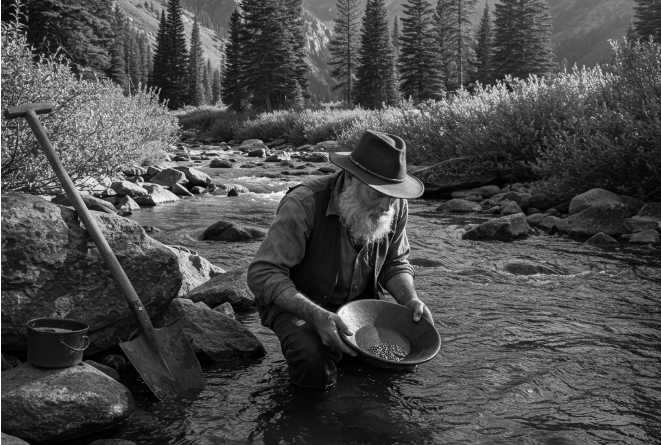I live in the Pikes Peak region, a place where, in the mid-1800s, thousands of fortune seekers flooded in, driven by one thing—gold. The promise of untold riches pulled them west, much like Silicon Valley today lures entrepreneurs chasing billion-dollar dreams.
These gold-seekers had a saying: “Pikes Peak or Bust.” But for most, it was more like “Pikes Peak to Bust.” The harsh reality? Very few prospectors ever made it rich. Most spent their days knee-deep in freezing mountain streams, swinging picks in dark mines, or gambling their last dollar on a claim that led nowhere.
A lucky few—like those who struck gold in Cripple Creek and Victor—became legends. But the vast majority? They left broke, disillusioned, or working in someone else’s mine just to scrape by.
The Entrepreneurs Who Cashed in on the Rush
The actual fortunes weren’t made in the mines but in the towns that popped up around them. The smart business owners didn’t risk it all on striking gold; they sold the things that the prospectors needed—food, tools, shelter, and entertainment.
- Saloons and Brothels – Where weary miners drowned their sorrows and spent their hard-earned wages.
- General Stores – Selling picks, shovels, pans, and dynamite.
- Boarding Houses & Restaurants – Feeding and housing the never-ending stream of workers.
- Blacksmiths & Outfitters – Keeping tools, wagons, and horses in working order.
And then, there was Levi Strauss.
Levi Strauss: The Original Main Street Success Story
Levi Strauss didn’t come west looking for gold—he came to sell pants.
In 1853, Strauss, a German immigrant, set up shop in San Francisco to sell dry goods to miners. He quickly realized that prospectors needed durable work pants that could withstand the harsh conditions of digging, climbing, and hauling.
His solution? Riveted denim jeans.
Partnering with tailor Jacob Davis, Strauss reinforced work pants with metal rivets, creating the first blue jeans—a product so tough it became the standard workwear for miners, ranchers, and laborers alike.
The gold prospectors may have had a 1 in 10,000 chance of striking it rich—but Levi Strauss built a company that still exists 170 years later.
Related Post: 6 Business Lessons From Levi Strauss – The Blue Jean Millionaire
The Role of Primary vs. Secondary Employers
Now, to be fair, a handful of prospectors did strike it big, but they didn’t stay prospectors for long. The ones who built real wealth weren’t just lucky—they became primary employers by establishing large-scale mining operations. These were the people who figured out how to scale, hiring laborers to dig for them instead of doing the backbreaking work themselves. And just like back then, it’s just as hard today to transition from a solo entrepreneur with an idea to a full-scale business that employs others.
Meanwhile, the Main Street businesses, also known as secondary employers, had near-zero financial risks, an abundance of eager customers, and didn’t expose the owners to the extremes of the elements. They didn’t have to bet everything on a high-risk venture; they simply positioned themselves to benefit from the success—or failure—of others.
Then vs. Now: The Modern Gold Rush
Fast-forward to today, and we see the same pattern. Entrepreneurs dream of becoming the next Elon Musk or Jeff Bezos, diving headfirst into high-risk startups with new tech and big ideas. It’s exciting, sure, but also incredibly risky.
Just like the gold mines of the past, today’s primary employers in the Pikes Peak region have shifted. Instead of prospectors chasing gold, the economic backbone is now driven by military installations like the U.S. Air Force Academy, Fort Carson Army Base, and NORAD. The high-tech industry has also taken root, with companies like Hewlett-Packard leading the way. And, of course, tourism plays a major role, drawing millions to world-famous attractions like the Garden of the Gods, the Olympic Training Center, and Pikes Peak itself. These industries function as today’s economic gold mines, employing thousands and fueling the success of countless Main Street businesses that serve them.
The reality? The failure rate for startups is brutal. Everyone talks about the unicorns—the billion-dollar startups that change the world—but for every one of them, thousands fail quietly in the background.
The Smarter, More Reliable Play
Just like in the Gold Rush, today’s Main Street businesses are the ones with steady, reliable success. They support the dreamers, the tech innovators, and the high-stakes players. They may not be glamorous, but they’re far less risky and much more sustainable.
Here’s a short list of businesses that thrive by supporting other businesses:
- Accounting & Tax Services – Every business needs to handle finances.
- Commercial Cleaning & Maintenance – Offices, restaurants, and stores all need upkeep.
- Marketing & Web Services – The modern version of a sign painter—helping businesses get noticed.
- IT & Tech Support – Because even the most innovative companies need help keeping things running.
- Logistics & Delivery Services – Getting products from one place to another.
Be the Pickaxe Seller, Not the Prospector
Ultimately, if you want to chase a big dream, go for it—but know the odds. Just like the prospectors of the Gold Rush, most will come up empty.
If you want consistent success, look at where the money is actually being spent. Supporting businesses—just like Levi Strauss, saloon owners, and general storekeepers—may not be as flashy, but they win more often and survive longer.
And in business, staying in the game is how you build real wealth.
Are your business ambitions that of the risky prospector, or are they that of the less risky Main Street businessman?












